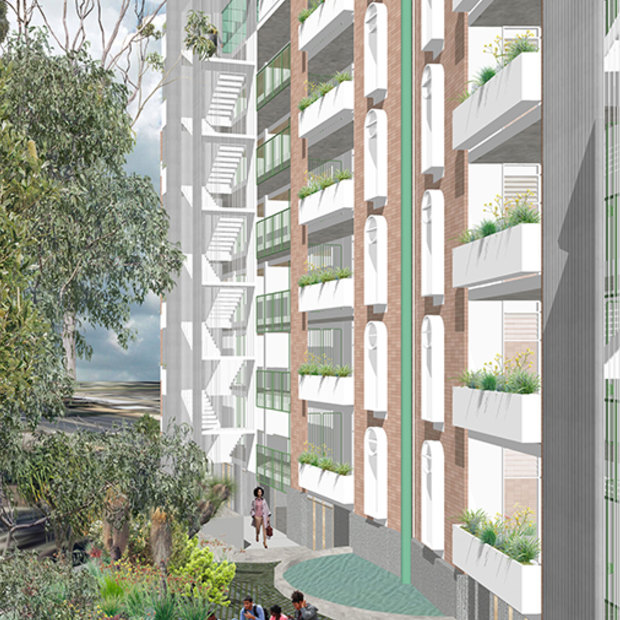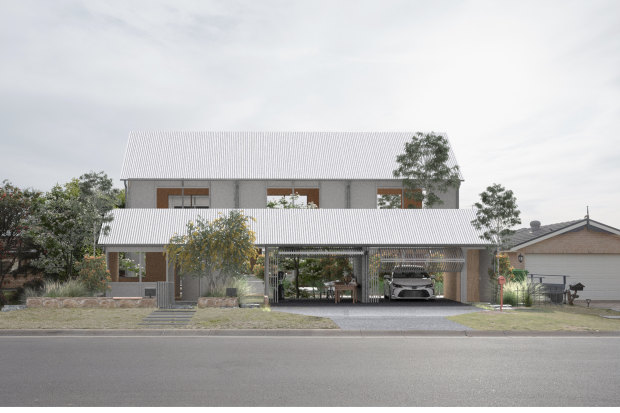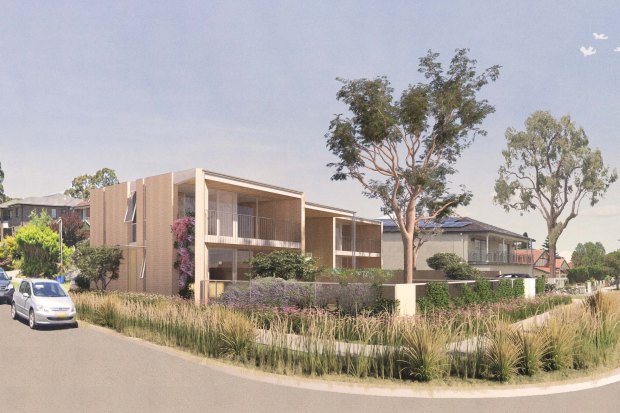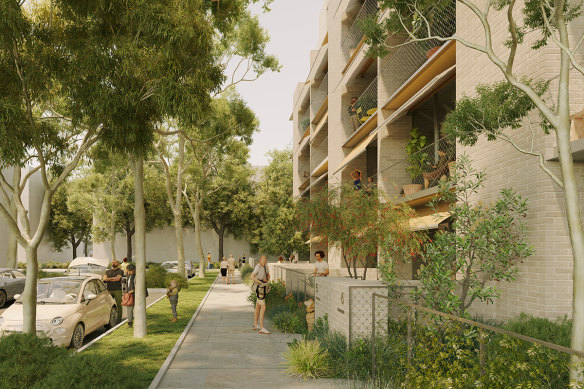This is what Sydney’s housing future will look like
These terrace homes and apartment blocks will be included in the NSW government’s “pattern book” of designs to reshape the city.
By Megan Gorrey

A mid-rise apartment design by New Zealand’s Spacecraft Architects. Credit: NSW government
The news
The NSW government has revealed the terrace homes and apartment blocks that will be included in its “pattern book” of designs that will attract a faster approval process for developers and builders.
Premier Chris Minns said the designs, comprising two terraces and three mid-rise unit blocks, would reshape Sydney and NSW, and help the government deliver more well-built homes, more quickly.
The patterns will play a critical role in the government’s push to build more homes around railway stations, and to lift the supply of medium-density housing – often dubbed the “missing middle”.
How we got here
The Minns government is on a mission to build 377,000 new homes in five years, not only because they are needed but because the state is required to do so under the National Housing Accord.
NSW also requires more diverse housing types, including townhouses, duplexes and mid-rise apartments, to meet the changing needs of households.
To this end, Minns last year launched an international housing design competition to devise a terrace house or mid-rise apartment for the 21st century. The winners would be included in the NSW Housing Pattern Book, which will contain designs and guidelines to accelerate the construction of terraces, semis, manor houses and small units in blocks of two to six storeys.
NSW government architect Abbie Galvin led a five-person jury panel to select the winning designs.

A terrace home design by Housing is a Verb that will form part of the NSW pattern book.Credit: NSW government
The use of pattern books for mass housing is not new; they helped shape the terrace houses of the 1900s, as well as walk-up apartments during the 1920s and 1930s, in Sydney and regional towns.
What are the winning designs?
Galvin said the homes were selected based on affordability, accessibility, adaptability to changing lifestyle needs, and sustainability.
“There was nothing overly complex. There was a real emphasis on spaces that were comfortable and healthy, with great ventilation, good outlook to landscape and gardens, a focus on orientation for the sun and how you could adjust that orientation depending on which way your site faced.”
The two terrace homes were designed by Officer Woods Architects and Housing is a Verb, a team comprising Other Architects, NMBW Architecture Studio and TARN.
The winning apartment blocks were designed by Andrew Burges Architects; Neeson Murcutt Neille, Finding Infinity and Monash Urban Lab; and New Zealand’s Spacecraft Architects.

A terrace home design by Officer Woods Architects. Credit: NSW government
A sixth design, by a group of students from the University of Sydney named In Common Studio, was recognised as a winner, but will not be featured in the pattern book.
What they said
NSW government architect Abbie Galvin: “I don’t think we’ll see immediate transformations; design and building takes time. But I can imagine we’ll start to see this gentle insertion of some of these projects into established suburbs. All the patterns come with a degree of flexibility. There’s going to be a lot of variation inherent in the [designs], but I also think we shouldn’t necessarily feel too scared about repetition. You get beautiful examples of repetitive design: people love the streets of Paddington, and Islington in London.”
Philip Oldfield, head of the University of NSW’s School of Built Environment: “The benefit of a pattern book is it would give developers, and even architects, certainty. The flipside with these pattern books is Sydney and NSW are diverse places. There are many different sites, topographies, climates and contexts, and making one pattern fit those different contexts could be quite challenging.”
Planning and Public Spaces Minister Paul Scully: “Bold and innovative ideas for terrace houses and mid-rise apartments are critical for increasing the supply of housing in NSW and will help fill the gap between detached homes and high-rise apartment buildings. We have less housing diversity today than we did 100 years ago; the pattern book, along with our fast-track [development application] process, will go a long way to reintroduce that diversity into our streets.”
What you need to know
The government says the pattern book will be available for anyone to use, and will “provide technical information” for users to share with their builders or design teams to build on their site.

Mid-rise apartment design by Andrew Burges Architects.Credit: NSW government
However, it will not be compulsory. The government hasn’t confirmed whether there will be a fee to access and use the designs.
What’s next?
The government is expected to launch the NSW Housing Pattern Book in mid-2025, and developers and builders who use one of those designs will have access to the fast-tracked planning pathway.
Some of the designs for the pattern book will be sourced from architects and builders; others will come from Galvin’s office.
The government will construct the designs as display homes on five sites provided by Homes NSW, Landcom and Sydney Olympic Park in Greater Sydney, in the next couple of years.
The public can also choose their favourite design on the Department of Planning, Housing and Infrastructure website for a “people’s choice” award to be announced early next year.
Further reading
They’re the “cockroaches” of Sydney housing. But what will terraces look like in future?
Meet the young people determined to revolutionise Sydney’s approach to housing
The missing middle that could help fix the housing crisis
Get alerts on significant breaking news as it happens. Sign up for our Breaking News Alert.